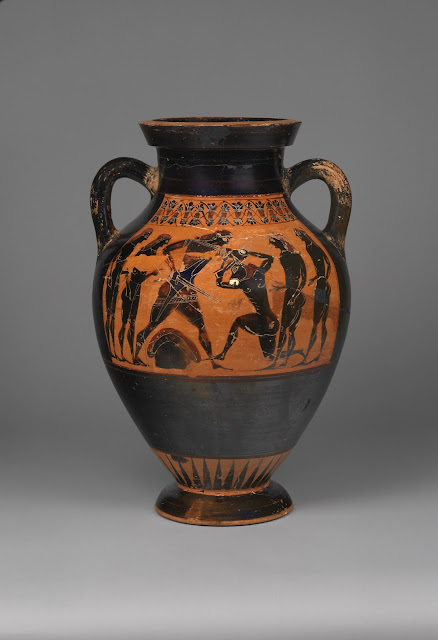 |
| Figure of Theseus from an original marble carved and installed ca. 470-460 BC - Temple of Zeus at Olympia plaster cast made in 1883 at Koniglische Museen, Berlin Museum of Fine Arts, Boston |
 |
| Eugène Delacroix Theseus, conqueror of the Centaur Eurytus (from the Parthenon Frieze) 1825 lithograph Metropolitan Museum of Art, New York |
from The Metamorphoses
For of the cruel Centaurs, thou most cruel Euryt, though
Like as thy stomach was with wine far over-chargèd, so
As soon as thou beheldst the bride, thy heart began to frayne
And doubled with thy drunkenness thy raging lust did reign.
The feast was troubled by and by with tables overthrown,
The bride was haled by the head, so far was fury grown.
Fierce Eurytus caught Hippodame, and every of the rest
Caught such as commèd next to hand, or such as he liked best.
It was the lively image of a city ta'en by foes,
The house did ring with women's shrieks, we all up quickly rose.
And first said Theseus thus, 'What ails? art mad, O Eurytus?
That darest (seeing me alive) misuse Pirithous,
Not knowing that in one thou dost abuse us both?' And lest
He might have seemed to speak in vain, he thrust 'way such as pressed
About the bride, and took her from them, fretting sore thereat.
No answer made him Eurytus (for such a deed as that
Defended could not be with words) but with his saucy fist
He flew at gentle Theseus' face, and bobbed him on the brist.
By chance hard by an ancient cup of image-work did stand,
Which being huge, himself more huge, Sir Theseus took in hand,
And threw 't at Euryt's head. He spewed as well at mouth as wound
Mixed clots of blood and brain and wine, and on the soilèd ground
Lay sprawling bolt upright.
– Ovid (8 AD), translated by Arthur Golding (1564)
 |
| Charles Townley (collector) Theseus battling the Centaur (after a terracotta Campana relief) ca. 1768-1805 drawing, with watercolor British Museum |
 |
| Richard Earlom after Giovanni Battista Cipriani Battle of Theseus and Centaur (after antique relief) 1789 etching and aquatint British Museum |
 |
| Ancient Rome Theseus examining his Father's sword 1st-century BC - 1st century AD carnelian intaglio Museum of Fine Arts, Boston |
 |
| Ancient Rome Head of Theseus 1st-century BC - 1st century AD carnelian intaglio Hermitage, Saint Petersburg |
 |
| Reinier Vinkeles after Jacobus Buys Medallions with antique portraits of Theseus and Romulus 1789 etching Rijksmuseum, Amsterdam |
 |
| Ancient Rome Theseus with conquered Minotaur ca. AD 75-100 sardonyx intaglio Kunsthistorisches Museum, Vienna |
 |
| Giovanni Pichler Theseus with conquered Minotaur (after Roman sardonyx intaglio now in Vienna) ca. 1760 agate cameo set into a ring Victoria & Albert Museum |
 |
| Bernard Picart Theseus with conquered Minotaur (after Roman sardonyx intaglio now in Vienna) 1722 engraving Philadelphia Museum of Art |
 |
| Ancient Rome Theseus and the Minotaur inside the Labyrinth ca. AD 300-400 mosaic Kunsthistorisches Museum, Vienna |
 |
| Ancient Rome Combat of Theseus and Sciron 1st century BC terracotta relief-panel Hermitage, Saint Petersburg |
"SCIRON – A famous robber who haunted the frontier between Attica and Megaris, and not only robbed the travellers who passed through the country, but compelled them, on the Scironian rock, to wash his feet, during which operation he kicked them with his foot into the sea. At the foot of the rock there was a tortoise, which devoured the bodies of the robber's victims. He was slain by Theseus, in the same manner in which he had killed others."
– Dictionary of Greek and Roman Biography and Mythology by William Smith (London: John Murray, 1873)
 |
| Anonymous Italian Maker Head of Theseus 16th century carnelian intaglio Hermitage, Saint Petersburg |
 |
| Anonymous Italian Maker Theseus restoring Helen to her brothers, Castor and Pollux (forgery of ancient gem) ca. 1800-1820 carnelian intaglio Metropolitan Museum of Art, New York |









































